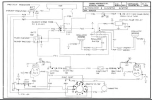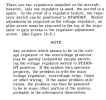- Joined
- Mar 15, 2016
- Messages
- 4,902
- Display Name
Display name:
Ari
I almost posted this in the thread about regretting a decision to upgrade planes. Anyhow, the left engine in the 310 got jealous of the attention the right one was getting from the recent magneto coil meltdown.
The wiring diagram shows that each engine’s alternator has its own voltage regulator and over-voltage protection relay. The over-voltage relays turn off the alternator when the voltage is too high. They can be reset by cycling the field power to the alternator.
The symptoms are that all works fine at idle. Both alternators put out a fair contribution to the airplane’s needs as long as I keep the throttle low. But if the left alternator is turned on when the engine is over ~1000rpm, both alternators turn off. Slowly increasing rpm from idle on the left side, I heard a faint whine in the headset before the alternators shut off. I feel like I saw a high voltage reading on the panel at some point during the test run but I can’t swear to a number. Cycling the field power on each alternator turns it back on, but if the left one is turned on at more than that ~1000rpm point they both shut off again almost immediately. I suspect that the over-voltage relays are tripping due to the left alternator putting out too high a voltage when run at higher speed.
In trying to trace down the problem, I found that the external filter capacitor lead on the left side was broken. I don’t know when that happened. In trying to find out the correct capacitor, though, I was informed that my Hartzell ALT-9522R alternator has an internal filter capacitor so the external one isn’t necessary.
I think that the best experiment would be to swap the two voltage regulators in the plane and see if the issue follows those or stays with the alternator. But it’s winter and I’d rather do some more measurements in the hangar if possible.
Does anyone have specific suggestions that I, a moron with a digital multimeter and only a few major electronics projects to my name (mostly guitar amplifiers, so lots of ~400VDC but not a lot of moving parts), can measure to help decide between ordering either an alternator or a pair of Plane Power voltage regulators?
The wiring diagram shows that each engine’s alternator has its own voltage regulator and over-voltage protection relay. The over-voltage relays turn off the alternator when the voltage is too high. They can be reset by cycling the field power to the alternator.
The symptoms are that all works fine at idle. Both alternators put out a fair contribution to the airplane’s needs as long as I keep the throttle low. But if the left alternator is turned on when the engine is over ~1000rpm, both alternators turn off. Slowly increasing rpm from idle on the left side, I heard a faint whine in the headset before the alternators shut off. I feel like I saw a high voltage reading on the panel at some point during the test run but I can’t swear to a number. Cycling the field power on each alternator turns it back on, but if the left one is turned on at more than that ~1000rpm point they both shut off again almost immediately. I suspect that the over-voltage relays are tripping due to the left alternator putting out too high a voltage when run at higher speed.
In trying to trace down the problem, I found that the external filter capacitor lead on the left side was broken. I don’t know when that happened. In trying to find out the correct capacitor, though, I was informed that my Hartzell ALT-9522R alternator has an internal filter capacitor so the external one isn’t necessary.
I think that the best experiment would be to swap the two voltage regulators in the plane and see if the issue follows those or stays with the alternator. But it’s winter and I’d rather do some more measurements in the hangar if possible.
Does anyone have specific suggestions that I, a moron with a digital multimeter and only a few major electronics projects to my name (mostly guitar amplifiers, so lots of ~400VDC but not a lot of moving parts), can measure to help decide between ordering either an alternator or a pair of Plane Power voltage regulators?


